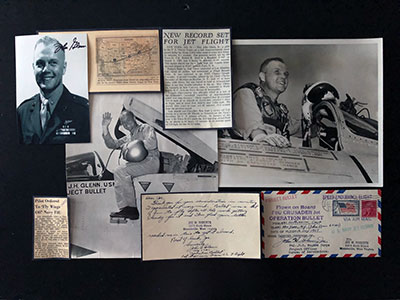 posted 04-15-2020 10:55 PM
posted 04-15-2020 10:55 PM
   
Below at bottom right is a fascinating signed John Glenn cover that I am very excited about. Why? Because it's the only known flown postal cover that had accompanied Glenn on his famous first supersonic transcontinental jet flight from coast-to-coast that led to his selection as one of the first NASA Project Mercury astronauts. Inside the cover is an insert card in which Glenn penned to cover owner Joe Roberts of West Virginia, in part, "Bullet" was a lot of fun to fly after all the work getting ready for it and I'm glad your letter [and cover] reached me in time to get it aboard. Best of luck, Joe. Sincerely, John Glenn (signed), Maj. USMC, "Operation Bullet," 1st supersonic trans-U.S. flight." The cover had been postmarked in Washington, D.C. in August 1957 when Glenn was back in his office as a project officer with the Navy Bureau of Aeronautics at the nation's capital.  Marine Corps Major John H. Glenn, Jr., got up in the morning of July 16, 1957, strapped into a Navy Vought F8U-1P Crusader, and took off from Los Alamitos Naval Air Station in California like a cannon shot. Three hours, 23 minutes, and 8.4 seconds later (a time based on a National Aeronautic Association formula for records), he touched down at Floyd Bennett Field in Brooklyn, New York, setting a transcontinental speed record at 726 mph. At a time when aviation records were still a big deal in both the media and in geopolitics, the feat put Glenn on the radar just before selections would be made two years later in 1959 for the first group of astronauts. Besides, he was already noted as a fearless and decorated pilot after 149 combat flights in World War II and Korea earning him a Distinguished Flying Cross in both wars and racking up a total of ten Air Medals. It was Glenn, as chief project pilot for Operation Bullet, that conceived, planned, and carried out America's first supersonic transcontinental flight, an effort that required two dangerous midair refuelings. Glenn came up with the name "Bullet" for the flight because he would fly faster than a bullet fired from a .45-caliber pistol. During a practice refueling run over Texas before the record flight, as reported by Air & Space Magazine in 2009, Glenn recalls, "I was plugged in and taking fuel when the North American AJ Savage tanker's right engine started belching black smoke. Then the left engine started doing the same thing. I pulled out the [refueling] drogue and flew wing on him, and he couldn't hold altitude. He got down to around 3,500 feet and ordered a bailout of his crew." Glenn watched the crew get out with three good chutes as the aircraft tanker descended and crashed in an open area. "It was full of fuel and went off like an atomic bomb," he says. An investigation later revealed that the ground support crew had mistakenly put jet fuel in the AJ's gasoline tanks. In Glenn's hometown of New Concord, Ohio, the pilot's mother had told a neighbor that her son would by flying over at a certain time that morning, and when the sonic boom hit, the woman came running to the Glenn house yelling, "Johnny dropped a bomb!" After covering nearly 2,500 miles at an average speed of Mach 1.1, Glenn landed his Crusader in New York with only enough fuel to have made one more pass around the airport. Upon his arrival he was greeted by his family and high-ranking military officials along with a full 26-member Navy band in his honor. The cross-country mission also had another objective; The airplane was a photo-reconnaissance flight as well. The onboard six cameras took panoramic images over the entire route from California to New York, another first, while flying about 35,000 feet high. Glenn's swept-back high wing turbojet F8U fighter had beat the previous record holder in 1955 of an F-84F Super Sabre by 23 minutes. His Crusader was the first-type jet fighter in the U.S. service to reach 1,000 mph making it the world's first aircraft carrier-based jet to break the speed of sound. The purpose of the Operation Bullet flight was to prove that the Pratt & Whitney J-57 engine could tolerate an extended period at combat power -- full afterburner -- without damage. During the post-flight engine examination, the jet engineers determined that the engine could perform in extended combat situations and all power limitations on J-57 were lifted from that day forward. Project Bullet secured Glenn's reputation as one of the nation's top ten test pilots in aviation history. The 36-year-old Marine fighter-test pilot became an inspiration to thousands of young people. The future astronaut throughout 1957-59 had been invited to make television guest appearances on the popular game shows "I've got a Secret" and "Name that Tune," thus reinforcing his nationwide popularity before his astronaut selection. John Glenn, of course, went on to become the first American to orbit Earth, got elected to the U.S. Senate for several terms, and flew a second time in space on Shuttle Discovery. But for one day in 1957--and again in 1962--he was the fastest flying Marine and highest-flying astronaut. | 











